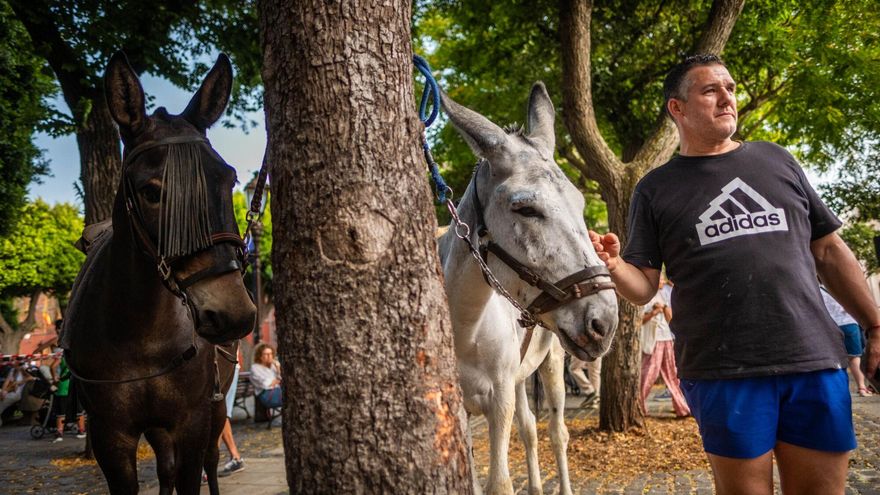
The popular Romería Chica de San Benito brings together 70 animals, parrandas, and curious locals in the streets this year, from the old town to the neighbourhood that lends its name to the festivities, to celebrate the agricultural roots of the municipality. San Cristóbal de La Laguna revives one of its most unique and beloved traditions once again, for the 19th time. It is a gathering that mixes history, identity, and cultural heritage surrounding the rural and livestock world of the municipality. On this occasion, the centre of attention was the Majorero donkey, one of the 29 native Canary species at risk of extinction, which the event typically honours in each edition. Since its recovery after the pandemic, in 2022, tribute was paid to the group from the Federation of Canary Native Breeds Associations (Faracan), making an exception for the Palmera sheep and the Canary camel.
Taking to the streets
The donkeys are once again taking to the streets of La Laguna. Not just them, although they are the stars of the day. Camels, cows, and even a dog… A whole array of fauna fills the starting point of this peculiar route, the Plaza del Adelantado, alongside their owners, waiting for the air to cool.
The Mayor
The mayor of La Laguna, Luis Yeray Gutiérrez, highlights the high participation of people of all ages “who come to see the parade and learn a bit more about the Majorero donkey, an animal that has shaped the agricultural history of the islands.” Additionally, the mayor emphasises “the march through the streets of the city, with animals, folkloric groups, fanfare, and traditional San Benito carts.”
Participation
The councillor for Festivals in La Laguna, Dailos González, recalls that the successful participation in this edition of the Night of the Donkeys adds to other significant milestones of the San Benito festivities, “which have demonstrated the strong sense of belonging and attachment this event evokes among the residents of La Laguna.”
Quite hot
The event, which once again winds through the historic streets of Aguere, does not disappoint anyone. Not even the heat that forced the starting time to be delayed by an hour, something that people appreciated. At 20:15, the temperature and humidity are particularly high in the Plaza del Adelantado, the starting point. Here, the organisers work tirelessly to ensure everything goes smoothly, including veterinarians to monitor the animals. Many essential roles go unseen, such as Fernando Hernández, the driving force behind Los Joroperos, or Santiago Cacho from Agate.
Endurance
The animals, along with their human companions, endure the heat as best they can. Generally, the donkeys fare well because one of their defining traits, particularly the Majorero, is their capacity for suffering and endurance in extreme weather conditions. Currently, there are 83 females and 62 males registered, most of them on their island, Fuerteventura, where they were introduced by the conquerors in 1450, in addition to Lanzarote, Gran Canaria, and Tenerife.
In first person
Vega shows with her bright eyes that she enjoys what she sees. She is five years old and accompanies her parents, Sandra and José, in this pleasant experience when the afternoon finally arrives after a stifling day. Passing by is the romera (pilgrim) of San Benito, Sheyla Garcia Martín, who, of course, could not miss it, and remarks with an expressive “what heat.” In La Laguna, at this hour, a slight breeze runs, but the mobile reads 27 degrees.
From Gran Canaria
Close by is the young Aníbal Vega Santana, who brings eight Majorero donkeys from Gran Canaria. He is from Valleseco but carries out his work recovering the native species in Tejeda. There, the animals are used in therapy tasks, especially with autistic children, and they also act as firefighters to prevent fires. Accompanying him is Platero -yes, Platero, in this case, and him-. The animal is 12 years old and is in his prime as they typically live around 35 years. Aníbal is also a veterinarian and arrives with his companion Claudia. It is his first time at this event, although he has participated in previous years at the livestock fair organised by Agate for San Benito, which takes place this weekend. He explains the characteristics of the animal, such as its small size, which is ideal for carrying loads in the island’s challenging terrain. At the farm, they have 23 breeding animals, and eight or nine individuals are born each year that are then put up for adoption. Fortunately, the breed is recovering.
Rural atmosphere
There is much of a rural atmosphere for a day in the centre of La Laguna. After paying tribute to the Federation of Native Canary Breeds and its great defenders like Juan Capote, the parade began with a slight delay. Animals linked to agricultural work and representatives of a primary sector that has seen better times fill the space, with the market of a lifetime as a silent witness -and closed-.
Flavour of history
A flavour of history and future, an attractive mix in the subsequent parade of the procession that arrives at Calle Embajador Alberto de Armas in the San Benito neighbourhood, passing through emblematic and evocative points such as Obispo Rey Redondo (La Carrera), Herradores, or Marqués de Celada (representing church, work, and nobility in three names). It is a festive and heartfelt march in which animals and their caregivers participated, accompanied by parrandas. Hundreds of locals, families, and many children gather on both sides of the roads taken.
Curiosity
Children with curious gazes, a mixture of surprise and respect before animals that form part of a past that is no longer commonplace but remains alive in memory and customs. They marvel at a very special afternoon where old La Laguna transforms into a living portrayal of past times. In the end, a collective toast marks the end of the festivities.
Agricultural origins
Beyond its playful character, this Romería Chica serves as a genuine reminder of Aguere’s agricultural and livestock origins, a journey to the past that connects with traditions predating the very conquest of the island. It is no coincidence that San Benito is the patron of farmers and livestock breeders. These festivities represent a claim of the fundamental role that the countryside has played in shaping La Laguna’s identity.
Pedagogy
The event also has a clear educational value, as it helps ensure that new generations understand the importance of the rural world in the history of the Canary Islands and the value of preserving both native species and the customs and traditions that have shaped the island’s landscape and culture.
Aesthetics
One of the most picturesque elements of the celebration is the balcony and window decoration competition organised by the Historical Centre Residents’ Association of La Laguna and the Friends of the Romería de San Benito Abad Association. This tradition involves residents from both the upper area, known as Villa Arriba, and the old town, Villa Abajo.
Competition
About thirty balconies compete to be recognised as the best decorated, keeping alive the tradition of adorning façades for the grand popular festivals. Floral motifs, colourful drapes, embroidered cloths, and Canary flags are the highlights of this decoration that not only beautifies the streets but also strengthens the sense of belonging and pride in local traditions.
Winners
The winners of this edition are properties on Avenida Lucas Vega (number 80) and Calle Marqués de Celada (number 36), in the Villa Arriba category. As for Villa Abajo, the winners are number 20 on Calle Marqués de Celada and number 17 on Calle Adelantado. This edition features 32 balconies, with 11 in Villa Abajo and 21 in Villa Arriba. The Residents’ Association evaluates the creativity of all the neighbour participants in the contest.
Identity
The Romería Chica de San Benito and its ‘Night of the Donkeys’ are, ultimately, a living testimony of La Laguna’s identity, a tradition that looks to the past to strengthen the present and project itself towards a future where the rural and urban continue to find spaces for mutual respect and encounter.
Subscribe to keep reading















